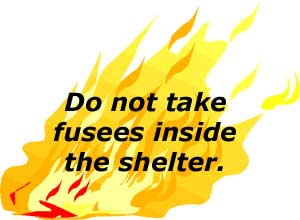
Back | Next | Home
Missoula Technology &
Development Center
 |
Table
of Contents Back | Next | Home |
Missoula Technology & Development Center |
The New Generation Fire Shelter

It is extremely important that you stay well hydrated when fighting fire. Drink water often, during your shift and when you are off duty. If you are well hydrated, your body can sweat and cool itself more effectively. This is particularly important during an entrapment.
Do not use your water to wet your clothing or your bandanna inside the fire shelter. Wet clothing conducts heat to the skin more quickly than dry clothing, so burns are more likely. As the water on the clothing evaporates, it increases the humidity inside the shelter. Moist air will cause more damage to your airway than dry air at the same temperature.
The best way to use your water is to drink it. Take canteens into your fire shelter if you have time. Continue to sip the water to replace lost fluids.
Never plan to share a shelter unless someone is without one. The shelter is designed for one person. Sharing a shelter greatly increases your risk of injury because it reduces the amount of insulating airspace and increases the chances your body will contact hot shelter material. If you canít avoid getting into someone elseís shelter, yell at them so they know you are coming in. Always enter from the side away from the flames or hot air, so you donít expose the occupant to the full force of the wind and heat. Your head should be by the other occupantís head.
If you are with a group, deploy your shelters close together. Adjacent shelters can provide added protection from radiant heat. In addition, it will be easier to communicate when the shelters are close together. Optimal shelter placement depends on the conditions. Select the best deployment sites available.
Some flammable items, such as fusees and gasoline, should not be taken into the shelter. Throw them as far away as possible when you deploy your shelter. Fusees burn at temperatures approaching 3,000 °F. The temperatures inside the shelter would rise quickly to fatal levels. You should also keep tools, such as pulaskis and shovels, away from the shelter so they do not cut the shelter material.

Throw your pack far away from the shelter. The pack may contain dangerous items, such as fusees.
If you are entrapped, do not delay your deployment—prepare for the worst.
If you have extra time, but cannot escape to a safety zone, use the time to increase your chances for survival. Make sure that:

| Top Back | Next Table of Contents |
|
| Missoula Technology & Development Center |
|